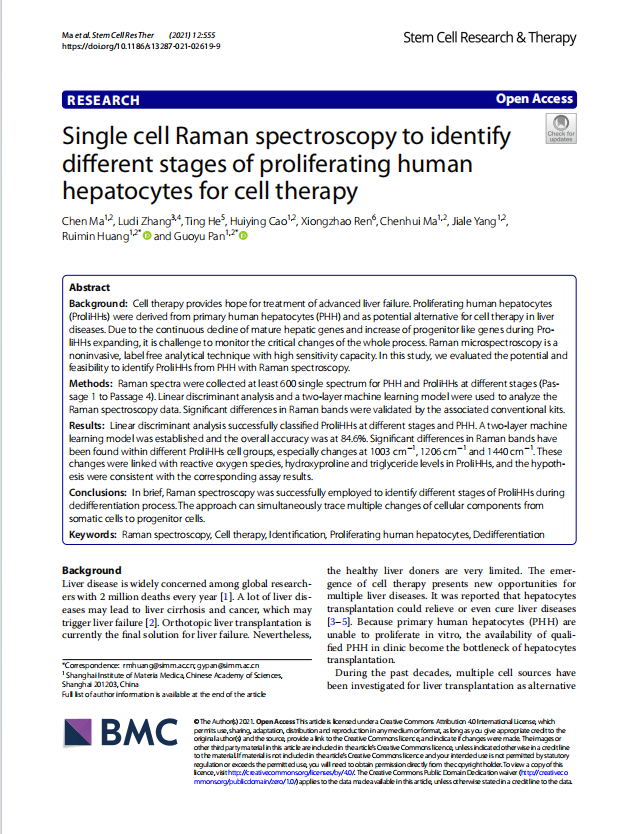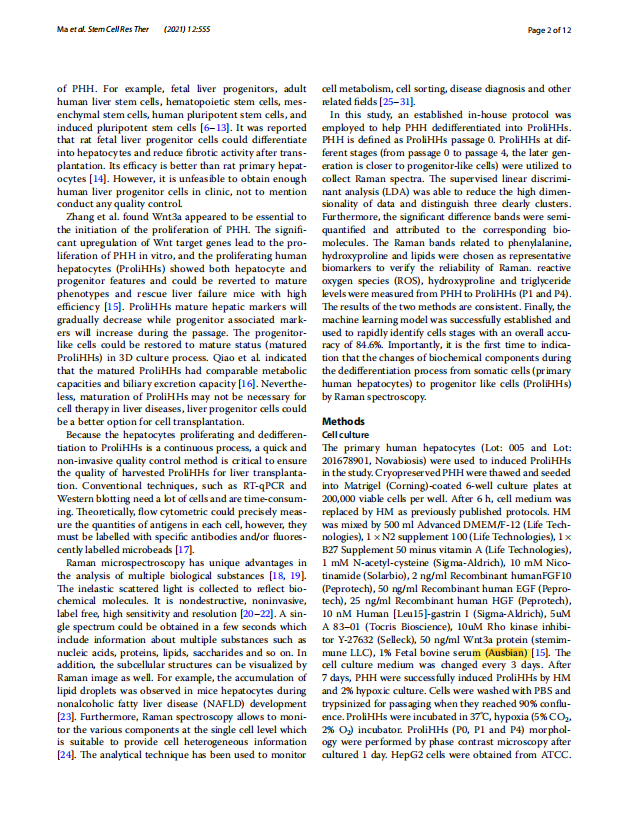單細(xì)胞拉曼光譜識別不同階段的人肝細(xì)胞增殖的細(xì)胞治療 二維碼
發(fā)表時間:2024-08-23 16:16 2021年10月,中國科學(xué)院上海藥物研究所(Shanghai Institute of Materia Medica, Chinese Academy of Sciences, Shanghai 201203, China )Ruimin Huang and Guoyu Pan研究團(tuán)隊(duì)在《Stem Cell Research & Therapy》發(fā)表論文,標(biāo)題為:“Single cell Raman spectroscopy to identify different stages of proliferating human hepatocytes for cell therapy”“單細(xì)胞拉曼光譜識別不同階段的人肝細(xì)胞增殖的細(xì)胞治療” Abstract Background:Cell therapy provides hope for treatment of advanced liver failure. Proliferating human hepatocytes (ProliHHs) were derived from primary human hepatocytes (PHH) and as potential alternative for cell therapy in liver diseases. Due to the continuous decline of mature hepatic genes and increase of progenitor like genes during ProliHHs expanding, it is challenge to monitor the critical changes of the whole process. Raman microspectroscopy is a noninvasive, label free analytical technique with high sensitivity capacity. In this study, we evaluated the potential and feasibility to identify ProliHHs from PHH with Raman spectroscopy. Methods:Raman spectra were collected at least 600 single spectrum for PHH and ProliHHs at different stages (Passage 1 to Passage 4). Linear discriminant analysis and a two-layer machine learning model were used to analyze the Raman spectroscopy data. Significant differences in Raman bands were validated by the associated conventional kits. Results:Linear discriminant analysis successfully classified ProliHHs at different stages and PHH. A two-layer machine learning model was established and the overall accuracy was at 84.6%. Significant differences in Raman bands have been found within different ProliHHs cell groups, especially changes at 1003 cm?1, 1206 cm?1 and 1440 cm?1. These changes were linked with reactive oxygen species, hydroxyproline and triglyceride levels in ProliHHs, and the hypothesis were consistent with the corresponding assay results. Conclusions:In brief, Raman spectroscopy was successfully employed to identify different stages of ProliHHs during dedifferentiation process. The approach can simultaneously trace multiple changes of cellular components from somatic cells to progenitor cells. 摘要 背景:細(xì)胞療法為晚期肝衰竭的治療提供了希望。增殖性人肝細(xì)胞(ProliHHs)來源于原代人肝細(xì)胞(PHH),作為肝臟疾病細(xì)胞治療的潛在替代方案。由于ProliHHs在增殖過程中成熟肝臟基因不斷減少,祖細(xì)胞樣基因不斷增加,因此監(jiān)測整個過程的關(guān)鍵變化是一個挑戰(zhàn)。拉曼顯微光譜學(xué)是一種無創(chuàng)、無標(biāo)簽、靈敏度高的分析技術(shù)。在這項(xiàng)研究中,我們評估了利用拉曼光譜從PHH中鑒定ProliHHs的潛力和可行性。 方法:收集PHH和ProliHHs在不同階段的至少600個單光譜拉曼光譜(Passage 1 ~ Passage 4),采用線性判別分析和雙層機(jī)器學(xué)習(xí)模型對拉曼光譜數(shù)據(jù)進(jìn)行分析。通過相關(guān)的常規(guī)試劑盒驗(yàn)證拉曼譜帶的顯著差異。 結(jié)果:線性判別分析成功地對不同階段的ProliHHs和PHH進(jìn)行了分類。建立了雙層機(jī)器學(xué)習(xí)模型,總體準(zhǔn)確率為84.6%。在不同的ProliHHs細(xì)胞群中發(fā)現(xiàn)了顯著的拉曼波段差異,特別是在1003 cm?1,1206 cm?1和1440 cm?1時的變化。這些變化與ProliHHs中的活性氧、羥脯氨酸和甘油三酯水平有關(guān),該假設(shè)與相應(yīng)的檢測結(jié)果一致。 結(jié)論:總之,拉曼光譜成功地識別了ProliHHs在去分化過程中的不同階段。該方法可以同時追蹤細(xì)胞組分從體細(xì)胞到祖細(xì)胞的多種變化。 該論文中,原代人肝細(xì)胞體外培養(yǎng)是使用Ausbian特級胎牛血清完成的。欲了解或購買Ausbian特級胎牛血清可以聯(lián)系北京締一生物400-166-8600.
|
|





